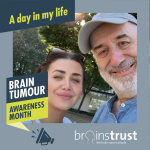March is Brain Tumour Awareness Month and this year we’re raising awareness of the all too often invisible impact a brain tumour diagnosis has on people’s lives.
 Many of the life changing consequences of living with and beyond a brain tumour are unseen. From our work with the the community we know that this leaves people feeling isolated and afraid, asking themselves ‘am I the only one?’. No one should feel alone when facing a brain tumour diagnosis. That’s why this Brain Tumour Awareness Month we’re shining a light on the hidden impact of living with a brain tumour.
Many of the life changing consequences of living with and beyond a brain tumour are unseen. From our work with the the community we know that this leaves people feeling isolated and afraid, asking themselves ‘am I the only one?’. No one should feel alone when facing a brain tumour diagnosis. That’s why this Brain Tumour Awareness Month we’re shining a light on the hidden impact of living with a brain tumour.
Throughout the month we’re amplifying your voices to break down the stigma. We’re hosting takeover days, handing our social media over to ambassadors from the brain tumour community. They’ll be sharing how their day to day life has been affected by a brain tumour diagnosis. We’re showing people they are not alone and helping the world understand what it’s like to live with a brain tumour, and we need your help…
Support the Brain Tumour Awareness Month campaign
Share. The simplest thing you can do to support brainstrust this Brain Tumour Awareness Month is to get sharing. We’re using our platform to amplify community voices and we need your help to spread this far and wide. Help us give a voice to the all too often silent impact of a brain tumour. You can follow the campaign on:
Facebook | Instagram | Twitter | LinkedIn
Donate. We’re fundraising to help us to continue to provide our vital services. Every penny raised throughout the month will help ensure that people have the support they need to live their best life possible.
Fundraise. If you want to go the extra mile for people living with a brain tumour, why not host a fundraiser.
- Visit brainstrust – JustGiving to create your fundraising page and start raising those vital funds for people living with a brain tumour diagnosis
- Email fundraising@brainstrust.org.uk to request a fundraising pack and sponsorship form or to discuss your fundraising ideas!
Access our support services
Throughout the month we’re sharing inspiring stories from the brain tumour community. If any of the stories we share throughout this month resonate with you, brainstrust is here to support you. We believe in a world where people with a brain tumour and their loved ones are involved, resourced, confident and connected. Through our personalised support we can help you get to a place where you are living the life you want to the best of your potential. Find out more about our support services:





